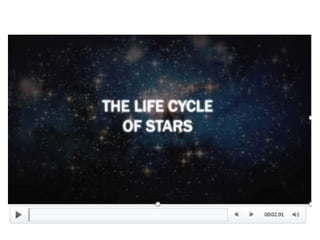Star's Life Cycle
- 2. EVOLUTION AND LIFE CYCLE OF STARS
- 5. EXAMPLES LOOK ON P. 764 in TEXT Book
- 6. STARS Life Cycles: • A Star goes through a life cycle just like humans would. Birth Life Death
- 10. Birth of a star A shockwave causes nebula gas and dust to collapse due to gravity. As the cloud collapses and shrinks due to gravity, it compresses the gas and starts to heat up inside (compression creates heat). It gets so hot that nuclear fusion starts inside the center of the cloud (a protostar forms).
- 11. Birth of a Star The high heat and temperature from the fusion reaction increases the forces of outward pressure and the protostar grows and starts to expand. Eventually, a balance between gravity wanting to collapse the protostar and the heat and pressure wanting to expand the protostar is met. A star is born and burns happily.
- 12. Shockwave Gravity compresses star Heats up fusion begins, pressure balances with gravity. Hydrogen is burning and balancing out the compression from gravity. REVIEW…
- 13. This balance between gravity and heat and pressure from fusion must be kept in order for a star to live peacefully. If a star does not burn enough hydrogen, then gravity will overcome it and it will start to collapse in on itself again. If a star makes too much energy, it will expand too much, thus shutting down the fusion reactions, ultimately causing the star to collapse again until fusion starts back up A star will continue to live happily as long as it balances internal pressure and gravity. Fusion for a star is like FOOD for us, With it we are sustained and can live. Without it, we die. HAPPY LIFE – Main Sequence
- 14. Implication More Mass • The more massive a star, the harder it has to try to overcome the force of gravity working to collapse it. More Fusion • The only way a star can overcome the collapsing force of gravity, is through the expanding heat and pressure of fusion. More Hydrogen • The more massive stars, need to burn more hydrogen than less massive stars.
- 15. Star live happy until it uses up its food: Hydrogen Stars live happy until they run out of food. It can no longer overcome gravity and starts to compress again. Bigger stars need more food to overcome gravity and thus use up there food faster (die earlier). A dying star changes from a main sequence start to another type of star. Depending on the mass of the star.
- 16. What happens when a star eats all its food? When it’s hydrogen inside its core runs out? THE STAR EXPANDS And is now burning Helium BECOMES A RED GIANT or SUPER GIANT
- 17. DEATH • At this time, gravity and heat and pressure are unbalanced. • The star begins to collapse as it cannot overcome gravity without fusion. • What happens after this point depends on the MASS of the star.
- 18. Medium – Low Mass Stars (like the sun). The stars core continues to collapse The star collapses so much that the enormous amount of heat produced causes leftover hydrogen in a cloud outside the core and He in the core to burn. This burning causes the outer atmosphere of the star to be wisped off into space leaving just the stars core behind. This core is called a white dwarf. White dwarfs are the same size as earth but way more dense.
- 19. High Mass Stars Hydrogen runs out in the core much more quickly because of its high mass, collapsing the core. It collapses so much that the inside heats up much more than inside a medium mass star. High mass stars are more massive, fusion of elements heavier than H and He take place, causing the star to expand rapidly into a super giant star. Eventuall y, the star runs out of fuel in the core causing fusion to stop. The star collapses in on itself and then explodes outward forming a supernova After the explosion however, the core of the star remain and becomes either a black hole or a neutron star depending on just how massive it is.
- 20. Supernova
- 21. From a Supernova… now what? 1.4 to 3 times the mass of the sun Core will collapse to about the size of a small city. Pressure from neutrons in the core stop the core from collapsing further. Neutron Star Greater than 3.0 the mass of the sun. Core will collapse to about the size of a small city. Pressure from neutrons in the core CANNOT stop the core from collapsing. Core shrinks down to a point called a singularity. Black Hole is formed.
- 22. Neutron Stars • Small • Extremely Dense - teaspoon weighs a mountain • Stupendous surface gravity • Rotate 1000 times per second (pulsar) neutron star marshmallow 3-megaton explosion
- 23. Black Holes • Massively dense core of a dead star compressed to a speck. • There is an imaginary sphere around the black hole called an event horizon. • Anything that goes into the event horizon can not escape its stupendous gravity.
- 24. Black Holes If Sun became black hole (not possible)…orbits of planets would be engulfed. event horizon BH
